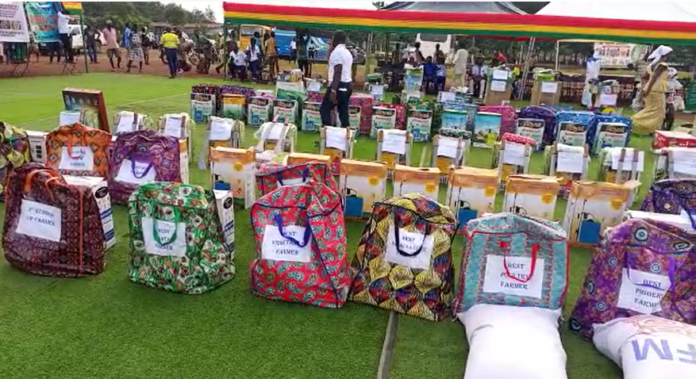The usual congregation of farmers across the country at durbars to climax the biggest national annual agricultural event, the National Farmers Day, will be absent on Friday.
This is because the Ministry of Food and Agriculture (MoFA) has injected new life into the celebration by dishing out awards at a night of banquet instead of the usual durbar held in the scorching heat.
Consequently, a dinner and awards night will be held at the University of Mines and Technology (UMaT) Auditorium in Tarkwa in the Western Region, where President Nana Addo Dankwa Akufo-Addo will crown the National Best Farmer.
Other deserving farmers would also be rewarded with various prizes at the national level.
In all, 15 categories of farmers would be honoured.
Aside from the overall national best farmer and the first and second runners-up, other categories that will be recognised are the National Best Female Farmer, the National Best Livestock Farmer, the National Best Physically Challenged Farmer, the Overall National Best Fisher, the National Best Marine Fisher and the National Best Inland Fisher.
Also to be rewarded are the National Best Fish Farmer, the National Best Fish Processor, the National Best Cocoa Farmer, the National Best Most Promising Young Cocoa Farmer, the National Best Most Enterprising Cocoa Farmer, the National Best Female Farmer and National Best Shea Nut Picker.
Innovations introduced
Another innovation in this year’s celebration is the introduction of the five-day Agricultural Fair dubbed “Agrifest Ghana 2023” which is an exhibition, where all 16 regions have stands at the Agrifest 2023 to showcase diversity in agriculture and food commodities.
Even though the five-day exhibition is a continuation of what was introduced in 2017 to climax the celebration, one significant departure from the past is that the exhibition is taking place in the Greater Accra Region, while the climax would be held in the Western Region, a different location from the exhibition region.
Investment
The Minister of Finance, Ken Ofori-Atta, who joined his colleague, Minister of Food and Agriculture, Dr Bryan Acheampong, to tour the exhibition grounds, said next year would see significant investment in agriculture to grow and expand the sector.
The ministers, accompanied by some officials of MoFA and the Finance Ministry, inspected some agricultural products and machinery displayed as part of the five-day agriculture festival ahead of the National Farmers Day.
Interacting with newsmen after the tour, Mr Ofori-Atta said the government would adopt a deliberate approach to grow the agricultural sector next year on the back of a GH¢10 billion investment in the sector.
He said the substantial investment was going to help bolster domestic production, reduce unnecessary imports while fostering food security in the country, making the country self-sufficient in agriculture.
“So in the year 2024, we are going to see a pretty deliberate approach to agriculture and once that begins, it is going to attract more people to go into agriculture, we will get the processing going and will be able to feed our students much better than we have,” Mr Ofori-Atta explained.
For his part, Dr Acheampong said the event was to celebrate the gallant Ghanaian farmers for their contributions in producing quality food for the nation.
On the theme: “Delivering Smart Solutions for Sustainable Food Security and Resilience”, the fair is aimed at equipping farmers, especially individual farmers with the capacity to use innovative methods to effectively produce food.
About 145 companies and organisations are participating in the agricultural festival this year.
Exhibits include a variety of agricultural products such as seedlings, local rice, processed food, tractors and irrigation and other equipment.
Since 2017, each day of the five-day event heralding the climax was dubbed “Regional Days,” which created the platform for each region to showcase its culture and agricultural commodities dominant in the region.
The essence of the five-day agricultural fair was, therefore, to create a platform for the award winners and the public to see and learn new technologies, machinery, research innovations and improvements, and processing of agriculture products.
The fair also offered business opportunities for stakeholders in and outside the sector to form partnerships that will ensure the overall benefit of the nation.
The National Farmers’ Forum has, however, been maintained because of its significance to the celebration.
Another departure from the previous celebration this year is that every region would celebrate the day with five regional award categories, made up of the Regional Best Farmer, the Regional Best Livestock Farmer, the Regional Best Female Farmer, the Regional Best Fisher, and the Regional Physically Challenged Farmer.
At the district level, all the 261 districts would celebrate the day at their respective district capitals.
Each district would have three categories, namely the District Best Farmer, the District Best Livestock Farmer and the District Best Crop Farmer.
Rationale
Explaining the rationale for the format of this year’s celebration, the Head of the Public Relations Unit of MoFA, Bagbara Tanko, said the ministry had decided to communicate agriculture differently.
Asked why the AGRIFEST and the award night are being held in different regions, he said “agriculture can no longer be confined to one corner.
We have split the two to enable people in Accra to get a feel of what is produced on the farm while allowing the farmers to also enjoy the plush ambiance of an award gala dinner.”
For the regional and district celebrations, Mr Tanko explained that it was to enable those who could not travel to Accra to have a feel of the celebration at their localities.
“The regional ministers and the district chief executives at the regional and district levels respectively will present the awards to the respective winners on behalf of the President,” he explained.
He said this year’s theme: “Delivering smart solutions for sustainable food security and resilience” resonated with the second phase of the Planting for Food and Jobs (PFJ 2.0) which focused on making agriculture attractive to the youth and was also driven by technology.
ALSO READ:

